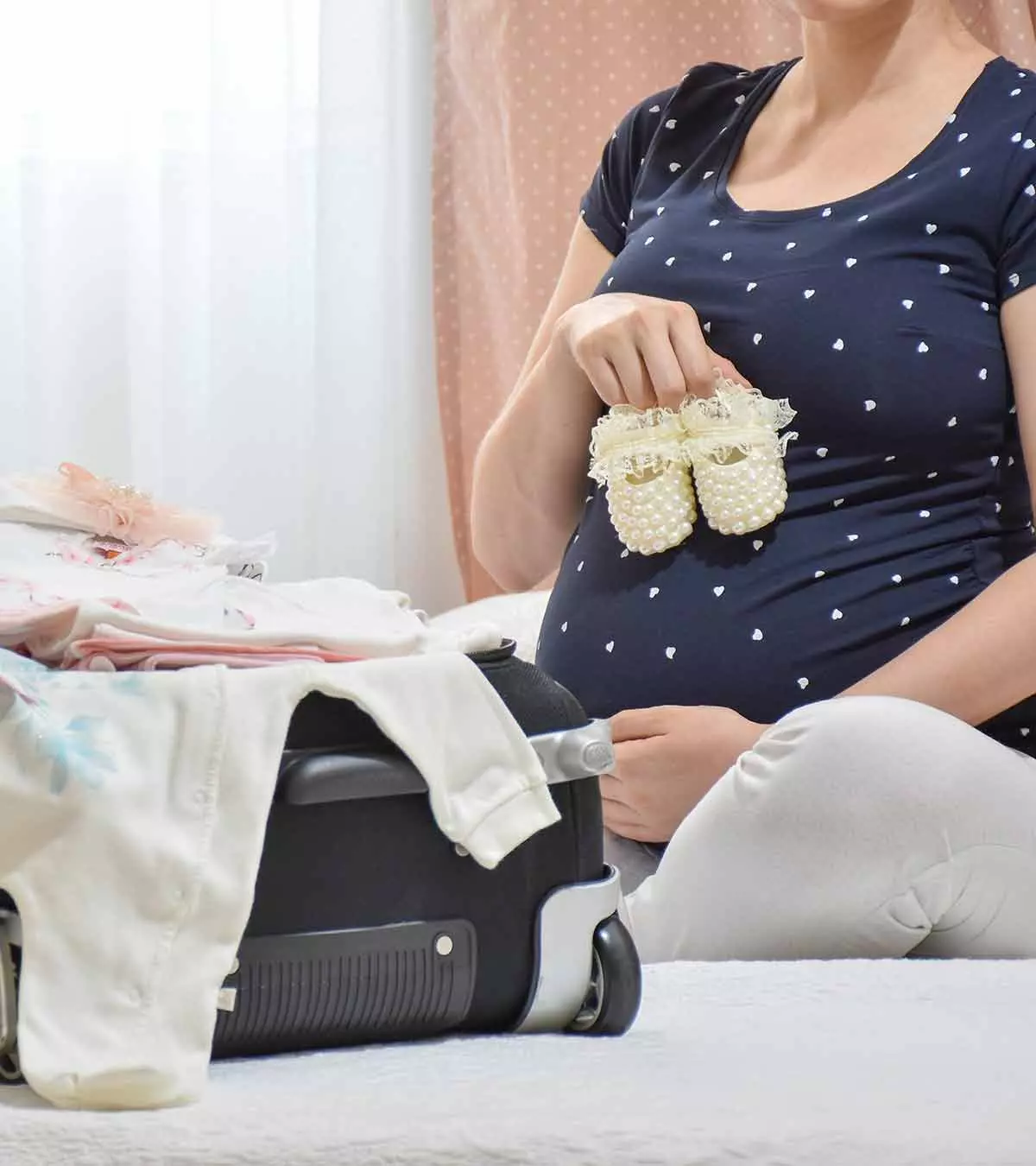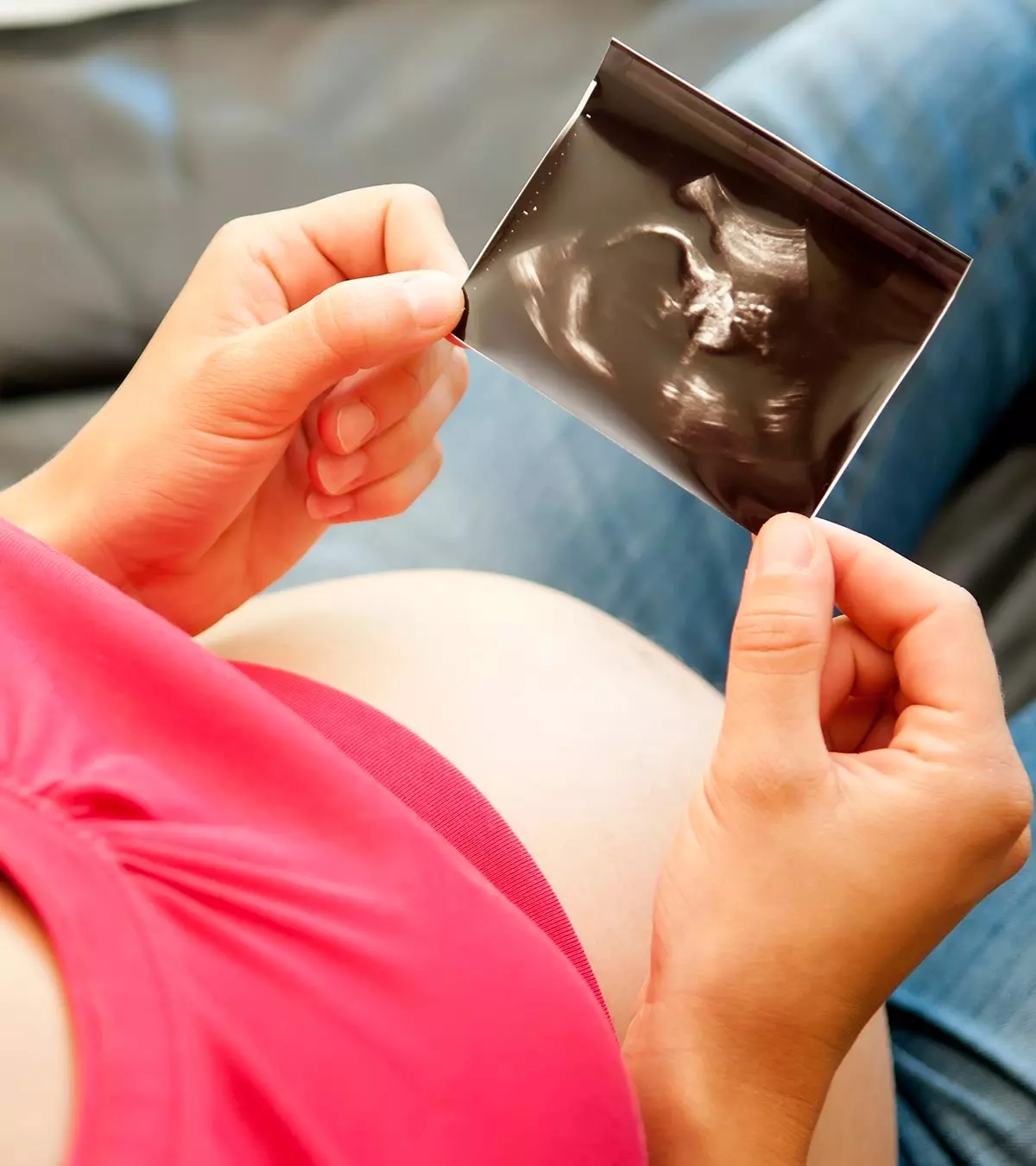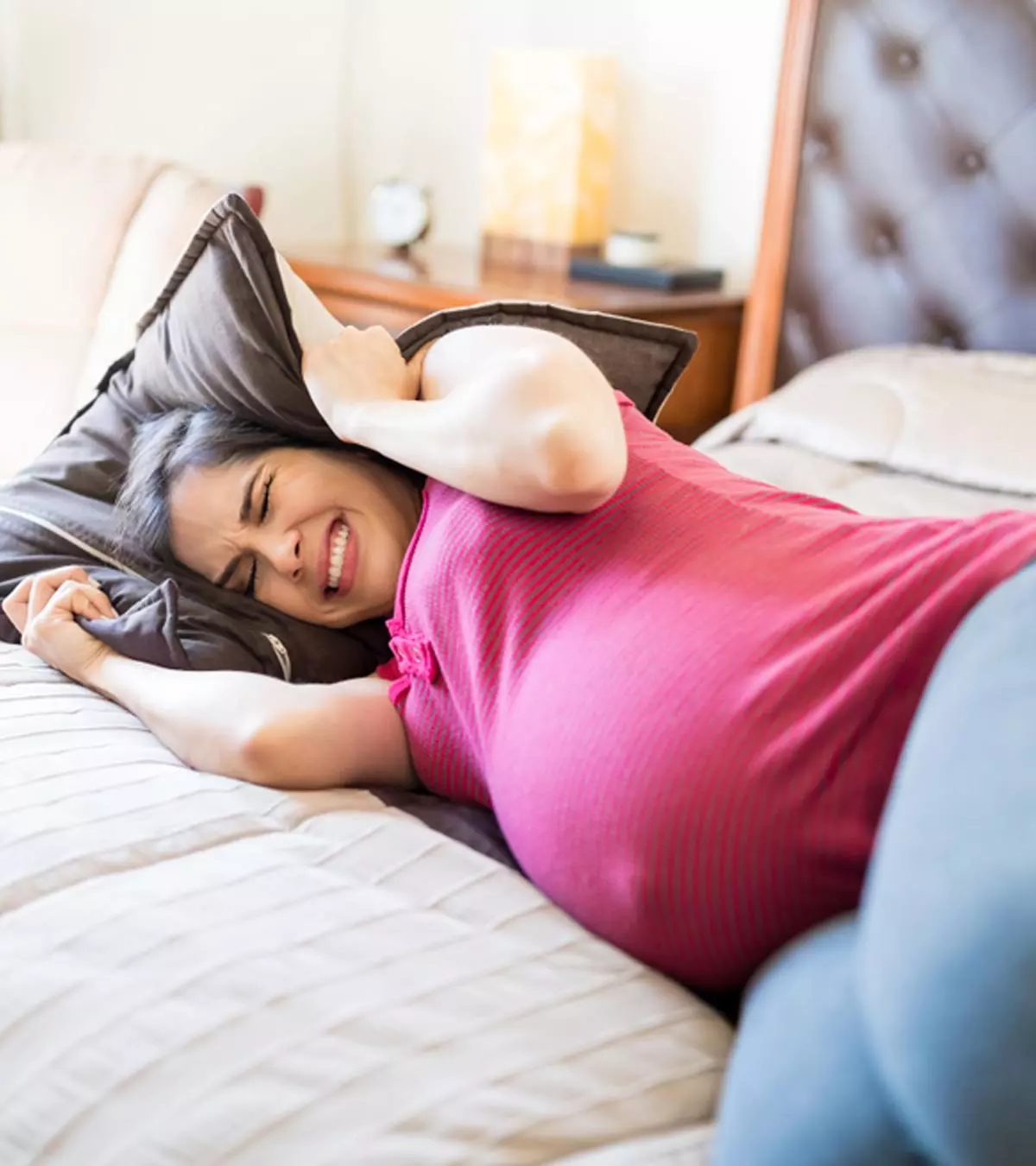
Image: Shutterstock
Contractions during pregnancy refer to the sensation of tightness and hardness in the uterine muscles. During a contraction, the pain or cramping usually starts in the lower back and moves to the front. Some pregnant women may feel as if they are having heavy menstrual cramping or back pain and pressure; however, not all pregnant women experience the same sensation. Even after a cesarean section, you may feel contractions for the first few days, which are called afterpains. However, these contractions last for about 7-10 days after postpartum recovery.

Read on to learn about the different types of contractions, how to manage them and keep yourself comfortable during active labor, and when to visit a healthcare provider. This article also addresses some frequently asked questions about pregnancy contractions.
Key Pointers
- Pregnancy contractions are marked by a tightness or hardness of the uterine muscles.
- Contractions for preterm labor start before the pregnancy reaches term (before 37 weeks).
- Contractions during active labor are often painful and signal an impending birth.
- During labor contractions, the cervix widens, indicating that labor is progressing.
- Pregnant women who experience painful or frequent contractions, especially before 37 weeks, should seek immediate medical help.
Different Types Of Contractions
You might have heard of the different names for contractions.
1. Braxton Hicks contractions
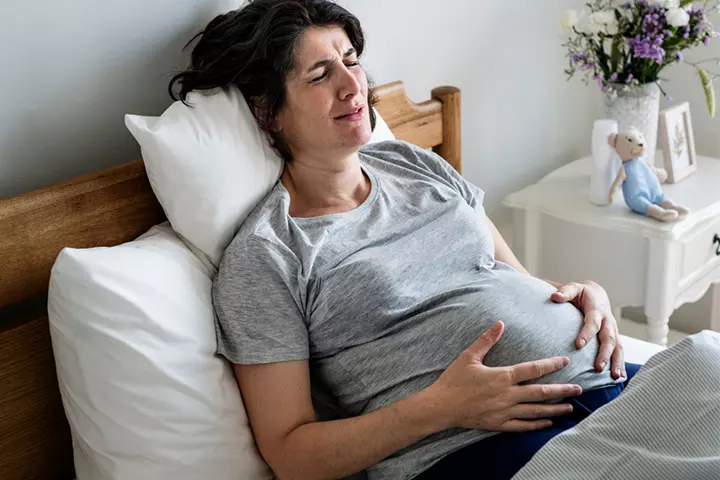
They are regarded as “prodromaliThe period of occurrence of the initial symptoms that indicate a preceding condition ” or false contractions that usually begin around the sixth week and get more pronounced in the second or third trimester. They are a normal part of pregnancy, and prepare the body for labor. They do not cause cervical dilationiThe opening of the cervix during labor to facilitate the progression of the fetus toward the birth canal (1).
What do Braxton Hicks contractions feel like?
The contractions are:
- Concentrated in the abdomen rather than the back
- Irregular and infrequent and do not increase in intensity
- Painless but uncomfortable
- Known to subside when you lie down, walk or empty your bladder
Causes of Braxton Hicks contractions
The following may trigger Braxton Hicks contractions (1):
- Intense physical activity
- Dehydration
- A full bladder
- Sexual activity
How to cope with Braxton Hicks contractions?
The following measures can help you to calm down or ease these contractions.
- Drink water to rehydrate yourself.
- Practice breathing exercises.
- Change your position or activity levels (sitting to walking or being active to lying down).
- Practice relaxation techniques, get a massage, take a warm bath, listen to music, read a book, or take a nap (1) (2).

If these techniques do not help, consult your healthcare provider for medical intervention.
 Quick fact
Quick fact2. Preterm labor contractions
These regular and true labor/birth contractions occur before the pregnancy reaches full-term (before 37 weeks). In some cases, it may lead to premature birth (3).
What do preterm labor contractions feel like?
You might be having preterm labor contractions if you have the following signs.
- More than five painful contractions per hour
- Frequent and regular uterine contractions
- Hardness of the abdomen
- Menstrual-like cramps
- Vaginal discharge and bleeding
- Dull, low backache
- Abdominal pain and pressure
- Pressure in the pelvic area
- Ruptured membranes
If you experience any of these, you should see a healthcare provider for further assessment.
Causes of preterm labor contractions
Factors that increase the risk of preterm labor contractions include (4)
- History of previous preterm labor
- Multiple pregnancies (twins, triplets)
- Short spacing between pregnancies
- Short cervix
- High-stress levels
- Certain infections
- Abnormal conditions of the placenta, cervix, or uterus
- Lifestyle triggers, including smoking, drugs, substance abuse, or obesity
 Quick fact
Quick fact
How to cope with preterm labor contractions?
To lower your risk of preterm labor, you may follow these early treatment measures until you see a doctor. These measures might also help reduce your risk of having a preterm baby (5).
- Keep sipping water and emptying your bladder as dehydration may also cause contractions.
- Take a warm bath as it could relieve you from uterine muscle contractions.
- Do not lie on your back. Lie down on one side and use a pillow at the back for support.
- Try tracking your contractions for one hour. Begin counting the minutes from the start of one contraction to the start of the next. If you have more than four to five in an hour, it signals preterm labor.
3. Early labor contractions
These are slightly uncomfortable contractions that feel like mild to moderate menstrual cramps. The cervix dilates to about three to four centimeters in this case (6).
What do early labor contractions feel like?
Some of the common symptoms that one might experience are as follows (7). All pregnant women may not have the same symptoms.
- Irregular contractions lasting about 30 to 45 seconds
- Irregular contractions 5 to 20 minutes apart
- Dull pain in the back
- Severe cramps
- Difficulty in breathing
- Fullness and pressure in the pelvic region
- Pain radiating from the back to the front
First-time mothers might have several hours of early labor contractions without any cervical dilation. You should go to the hospital or call your delivering provider.
4. Active labor contractions
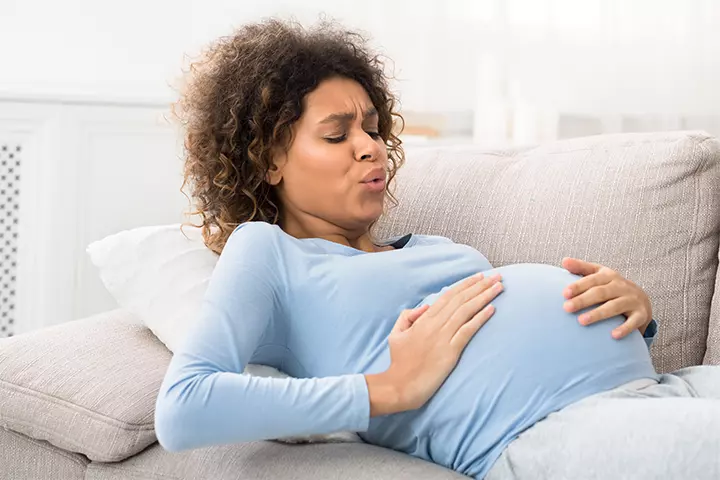
These are painful labor inductions that become more pronounced and indicate delivery is approaching. The cervix dilates to about four to seven centimeters in this stage (6).
What do active labor contractions feel like?
The following symptoms may indicate active labor contractions (7):
- Contractions lasting between 50 and 75 seconds
- Contractions two to three minutes apart
- Pressure and pain in the back as the baby ascends down the birth canal
- A strong urge to push
You may also experience other signs of labor such as nausea, lightheadedness, chills, hot flashes, gas, and vomiting, along with active birth contractions.
Stefanie, a mother of five, shares her experience with active labor contractions. She says, “I began having the same pre-labor symptoms that I had been having every day for almost two weeks. It started in the early afternoon but felt no different.”
However, the contractions became regular and more painful during the day, occurring every six to seven minutes, which made her realize that she may be into labor.
She adds, “The contractions kept coming. I knew it was time to call the doctor and head to the hospital. After speaking to the doctor, I called my dad to stay with the kids. Shortly after that call, the contractions began coming much faster, and I was in agony. By the time my dad arrived, I was on my hands and knees on the floor, crying. The contractions were coming every 1 1/2 to 2 minutes… Just when a contraction would ease, I’d start to get another one (i).” Upon arrival at the hospital, the medical staff checked her and found that she was dilated to 5cm and fully effaced.
What causes contractions during labor?
Contractions are caused when the pituitary gland releases the oxytocin hormoneiA chemical messenger and hormone that is involved in childbirth, lactation, and social bonding , which stimulates the uterine muscles to tighten and relax.
These actions continue to help dilate your cervix during birth and push the baby’s head onto the cervix to help it in its effacement or thinning more (8).
5. Transition contractions
These are considered the most painful part of labor. They last for 60 to 80 seconds, with two to three minutes apart. The cervix dilates to about eight to ten centimeters (6) (9). They are associated with intense pressure in the rectal and vaginal regions. You may also experience vomiting, nausea, and shaking.
6. Back labor
Having pain in your lower back during labor is called back labor. Back contractions can be felt when the back of the baby’s head presses against the mother’s tailbone and lower spine during labor. Medically, this position is known as the occiput posterior position.
What Does Back Labor Feel Like?
The following feelings are felt during back labor:
- Pain that is accompanied by painful spasms
- Intense or excruciating pain
- With each contraction, the intensity of pain is more intense and may not subside or ease in between
Feeling pain in your back during labor can start when you’re having strong contractions, and it might happen even before that. The back pain sticks around throughout labor and can worsen when contractions kick in (10).
How to keep yourself comfortable during active labor and transition contractions?
The following measures might help you deal with the pressure and pain of contractions (11).
- Take a shower or a bath.
- Walk or change positions.
- Drink water as it could give you enough strength to go through the labor.
- Get as much rest as possible.
- Eat well.
- Get a massage done by your partner. A lower-back massage and foot massage could make you feel good.
- Practice meditation, yoga, and other relaxation techniques. These might help you to focus and gain energy.
 Quick tip
Quick tip
Your doctor may discuss the pain management techniques, including oral medications and/or epidural anesthesia.
What Generally Happens In The Hospital?
Once you are at the hospital after the true contractions have started, here is what you may expect:
You will usually start in the triage area and have two monitors placed on your abdomen for monitoring the baby’s heart rate tracing and your contraction pattern. -You will be asked questions about your symptoms regarding pain, frequency and intensity of your contractions. The nurse will check your cervix and if you are found to be in active labor will you move to a labor room. -She will then call your doctor to know you are there and get any orders that may be necessary.
Frequently Asked Questions
1. Do contractions hurt?
It depends on the type of contractions you are experiencing. True labor contractions are usually more painful than Braxton Hicks. But the intensity of pain varies from one woman to another.
2. Do Braxton Hicks contractions turn into real contractions?
Braxton Hicks contractions do not turn into real labor contractions. They are false labor contractions that do not cause cervical dilation or lead to birth (1).
3. When do real contractions start during pregnancy?
Real contractions are likely to start after the 37th week. If they occur before the 37th week, they are considered preterm contractions (12).
4. Will the baby move during contractions?
Yes, the baby will move down your pelvis during the first stage of labor and help your cervix to dilate (13).
5. Does the baby move less before labor?
No, the baby must be active during labor. Call the medical experts if there is a decrease in the movement, as it may indicate fetal distress (14).
Distinguishing between the types of contractions during pregnancy is a challenging task. Nevertheless, it would be best to remain attentive to each signal your body gives you. There could be certain scenarios when you need to see a doctor soon, such as when you notice an increased frequency of contraction, vaginal discharge, severe pains, or feel any membrane ruptures. These may indicate that you are entering labor. Note the minutes of contractions, and hydrate yourself. Once you reach the hospital, the delivery team will be by your side to assist you towards a safe delivery.
Infographic: Breathing During Labor
Contractions during labor may be uncomfortable, and women experience them with different intensities. Learning breathing techniques may help you manage the pain better and experience smooth and comfortable childbirth. Check out this infographic to learn about breathing patterns at different stages of labor.
Some thing wrong with infographic shortcode. please verify shortcode syntax
Braxton hicks are a type of contraction experienced during labor. This informative video will help you understand the causes, signs, diagnosis, and treatment
Personal Experience: Source
MomJunction articles include first-hand experiences to provide you with better insights through real-life narratives. Here are the sources of personal accounts referenced in this article.
i. Liliana’s birth story;https://www.lexieloolilyliamdylantoo.com/2011/08/lilianas-birth-story.html
References
1. Deborah A. Raines and Danielle B. Cooper; Braxton Hicks Contractions; StatPearls Publishing (2025).
2. Common Discomforts During Pregnancy; UNM Hospitals
3. Preterm labor; U.S. Department of Health and Human Services National Institutes of Health
4. Preterm Labor and Birth; The American College of Obstetricians and Gynecologists
5. Preterm (Early) Labor; UNM Hospitals (2016)
6. Overview of Labor; Stanford Medicine Children’s Health
7. Contractions; Healthdirect, Australian Government, Department of Health
8. Contractions During Pregnancy: What to Expect; Healthwise Staff; British Columbia
9. Stages of Labour; Mid Cheshire Hospitals, NHS Foundation Trust
10. Back Labor; Cleveland Clinic
11. Labor F.A.Q; Family Birth Place; University of Illinois Hospital & Health Sciences System
12. When does labor usually start; NIH
13. The stages of labor and birth; NHS
14. Am I in labor?; Mount Sinai
15. Positions for labour and birth; Pregnancy Birth and Baby
Community Experiences
Join the conversation and become a part of our nurturing community! Share your stories, experiences, and insights to connect with fellow parents.
Read full bio of Dr. Erica Montes
Read full bio of Rebecca Malachi
Read full bio of Swati Patwal
Read full bio of Dr. Joyani Das








